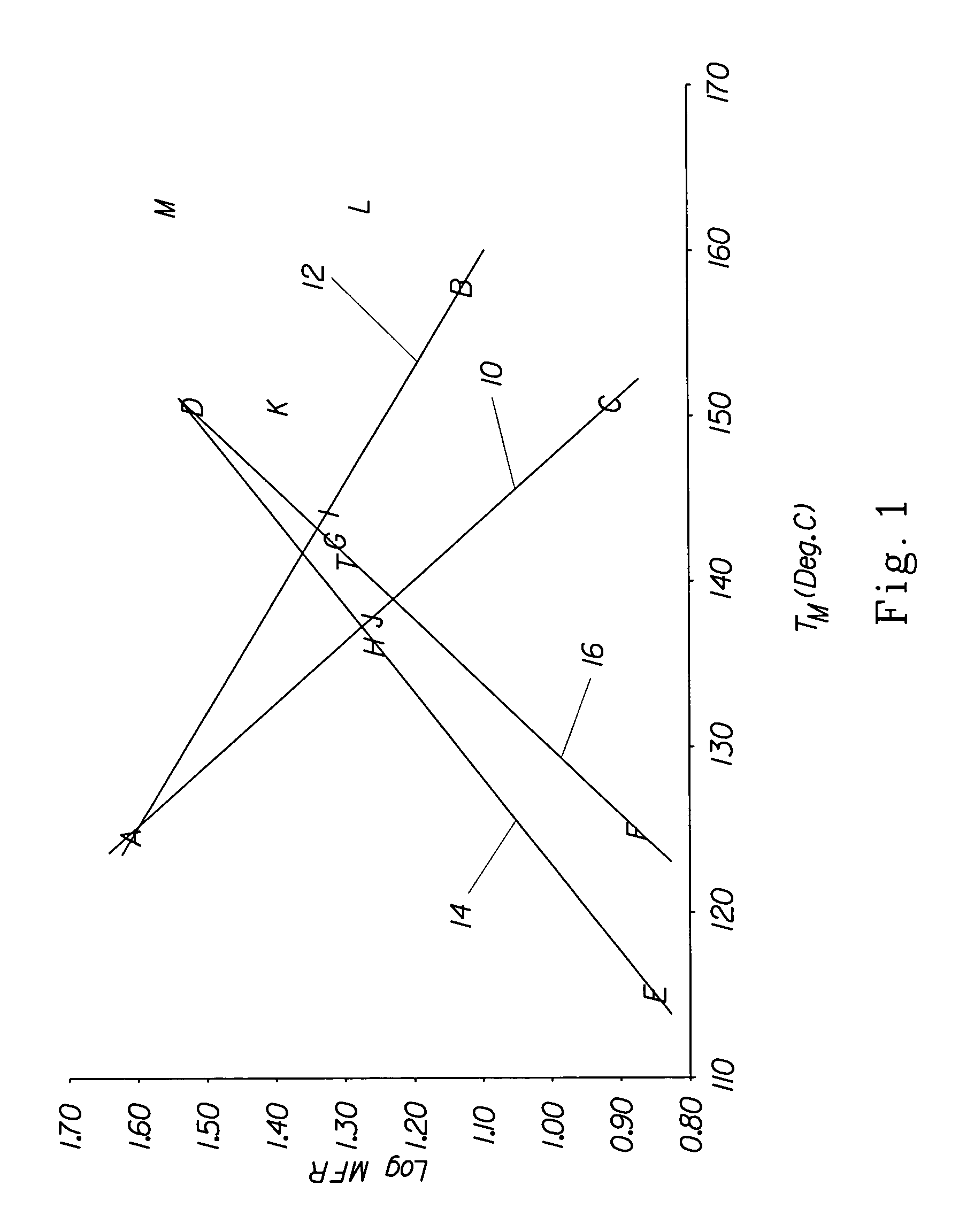Fibers and nonwovens comprising polypropylene blends and mixtures
a technology of polypropylene and blends, which is applied in the direction of conjugated synthetic polymer artificial filaments, textiles and paper, etc., can solve the problems of difficult production of polypropylene for use in nonwovens, additional challenges, and short residence time available for structure formation, so as to achieve a wide range of composition and melt flow rate variation
- Summary
- Abstract
- Description
- Claims
- Application Information
AI Technical Summary
Benefits of technology
Problems solved by technology
Method used
Image
Examples
example 1
[0115]This example describes the preparation of miscible (or at least highly compatible) PP / RCP blends with broad composition and broad molecular weight distributions comprising one polypropylene homopolymer and a propylene / ethylene random copolymer of different crystallinity (as measured by the average melt temperature) and melt flow rate.
[0116]The blends were prepared by dry-blending followed by compounding of a polypropylene homopolymer resin with a RCP resin in a polymer extruder to achieve optimal melt miscibility of the blend components with one another. While no analysis was made, it is believed that these resins also contained effective amounts of minor ingredients (e.g., antioxidants). The extruder used for the following examples is a Werner & Pfleiderer (30 mm diameter 40:1 length to diameter ratio) co-rotating twin-screw extruder set at 300 RPM with the five heat zones set at 180, 195, 205, 200 and 213° C. respectively, resulting in an average melt temperature of 229° C. ...
example 2
[0120]Neat or compounded materials were melt spun into fibers using a two extruder system, where each extruder is a horizontal single-screw extruder. The extrudate rate from each extruder to the spinpack is controlled by a metering melt pump that feeds a 4-hole spin pack (Hills Incorporated, W. Melbourne, Fla.). The extruders were set up to deliver the resin or resin blend to the melt pump at a temperature of about 230° C. In all examples the spinpack is fitted with a spinneret for a round hole, and distribution plates for a sheath-core cross-section. For the monocomponent fibers of this example, the same resin is used in both extruders at a sheath-to-core ratio of approximately 50:50. The extruder / melt pump / spinpack system is mounted on an adjustable height platform. In these examples, the mass throughput was maintained constant at approximately 0.8 grams / hole / minute and the spin line length was maintained constant at a distance of approximately 1.78 meters. The molte...
example 3
Inclusion of Immiscible Components
[0123]This example describes preparation and evaluation of samples that incorporate a fraction of an immiscible component (second subgroup polymers).
[0124]Dispersions of such second subgroup polymers in various polypropylene resins or resin blends were prepared as described in Example 1 above. Table 3 shows the composition of the dispersions of this example.
[0125]
TABLE 3CompositionResin / blend DesignationOBlend: 75% M / 20% AdFlex1 / 5% HDPE2PBlend: 75% K / 20% AdFlex1 / 5% HDPE2QBlend: 75% I / 20% AdFlex1 / 5% HDPE2RBlend: 75% G / 20% AdFlex1 / 5% HDPE21ADFLEX Z104S from Basell Polyolefins of Wilmington, DE.205862N HDPE from Dow Chemical Company of Midland, MI.
[0126]These dispersions were then spun into fibers at an extrusion rate of about 1700 meters / minute using the apparatus described in Example 2 above. Table 4 lists various mechanical properties for the fibers.
[0127]
TABLE 4CompositionOPQRDraw / Yield Str. ~30%46685632Tensile Strength155160163140Draw Str. / Tens. S...
PUM
| Property | Measurement | Unit |
|---|---|---|
| melt temperature TMb | aaaaa | aaaaa |
| melt temperature TM2 | aaaaa | aaaaa |
| melt temperature TM2 | aaaaa | aaaaa |
Abstract
Description
Claims
Application Information
 Login to View More
Login to View More - R&D
- Intellectual Property
- Life Sciences
- Materials
- Tech Scout
- Unparalleled Data Quality
- Higher Quality Content
- 60% Fewer Hallucinations
Browse by: Latest US Patents, China's latest patents, Technical Efficacy Thesaurus, Application Domain, Technology Topic, Popular Technical Reports.
© 2025 PatSnap. All rights reserved.Legal|Privacy policy|Modern Slavery Act Transparency Statement|Sitemap|About US| Contact US: help@patsnap.com


